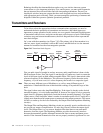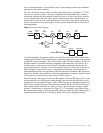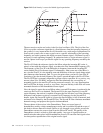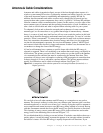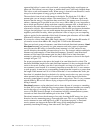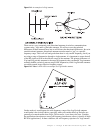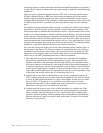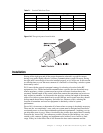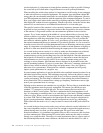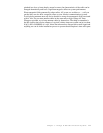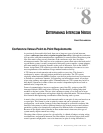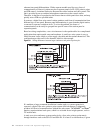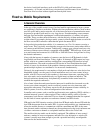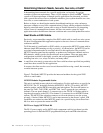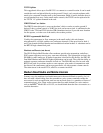110 Handbook of Intercom Systems Engineering
wireless beltpacks, it is important to locate the base antennas as high as possible. Getting a
few extra feet up will often make a large difference in overall system performance.
When installing the wireless base station it is important to avoid locating it near computer
or other microprocessor controlled equipment. All computer type equipment radiates RF
energy that can cause harmful interference in even the best wireless equipment. Likewise,
your RF equipment may interfere with the operation of the computer equipment. Try not to
have your wireless base station in the same rack as lighting controllers, audio processors or
other highly RF radiant electronic equipment. Whenever possible, locate the wireless base
station in its own enclosure to avoid harmful interference to or from other gear.
The specific location of the antennas is also extremely important. Antennas should never
be placed in close proximity to large metal surfaces that are parallel to the active element
of the antenna. A large metal surface can cause numerous problems in most wireless
systems. Try to locate antennas in the middle of a room (when inside) as far away from
reflective surfaces as possible. When using omni directional antennas inside, try hanging
them upside down with the ground plane on top, near the ceiling. This will provide the
most effective radiation pattern. It is also a very good idea to get as much space between
the transmit antenna and the receive antenna as is practically possible. As was covered in
an earlier section, this will avoid the phenomenon known as desensing and increase system
range. It is important to note that having the receive and/or transmit antennas as high up as
practical is often more beneficial than increasing the output power of the transmitter(s).
As covered in the previous section, it is critical to make sure that antennas are polarized
the same on both the transmit and receive end of the wireless system. In wireless
communications systems, the deciding factor lies with the beltpacks. Since the antennas on
the beltpack will normally be vertically polarized it is important to ensure that the base
station antennas are also vertically placed. Never mount an antenna using part of the
working or active elements. Most antennas that are designed to be mounted come with
specific mounting hardware. Trying to rig some other “innovative” mounting solution will
almost always result in reduced system range and performance. Also, don’t paint or
otherwise cover you antennas. Some paint has a metallic component and will greatly
impact system performance in a negative way.
In some extreme applications, it may be desirable to have multiple antenna locations for an
individual wireless base station. This technique can greatly increase the effective range of
the system if the everything is done just right. If not, it will most assuredly degrade overall
system performance. The first thing to remember is that splitting the transmit antenna is
never permissible! This is tantamount to setting up a frequency interference source right
next to your operational area of coverage.
Splitting receive antennas can sometimes be a good idea. The key thing to remember here
is the line impedance must be properly maintained. This means you should not use a
standard “T” connector to perform the split. The most common device used for this
function is a Mini Circuits splitter. This device maintains the 50 ohm impedance on all
legs. It is important to remember there is no such thing as a free lunch. Splitting antennas
comes at a price. When you add a second antenna the signal from each antenna is reduced
by at least 3dB. This loss then needs to be figured into the total loss/gain calculation for
proper system performance. Multiple antenna configurations can be very challenging.
When faced with the need to do so, it may be time to consult with an RF professional for
help.
As covered in the previous section, make sure you have selected a coaxial cable that is of
the correct impedance and has a loss per foot low enough to support the length necessary
without having more loss than you have antenna gain. Be sure to note with omni
directional antennas, it is sometimes acceptable to have a dB or two more cable loss than
you have antenna gain. When running RF coaxial cable, make sure the cable is not bent
sharply as to crimp the cable. The magic of coaxial transmission lines is a direct result of
the relationship between the center conductor, the dielectric and the shield. If a cable is



